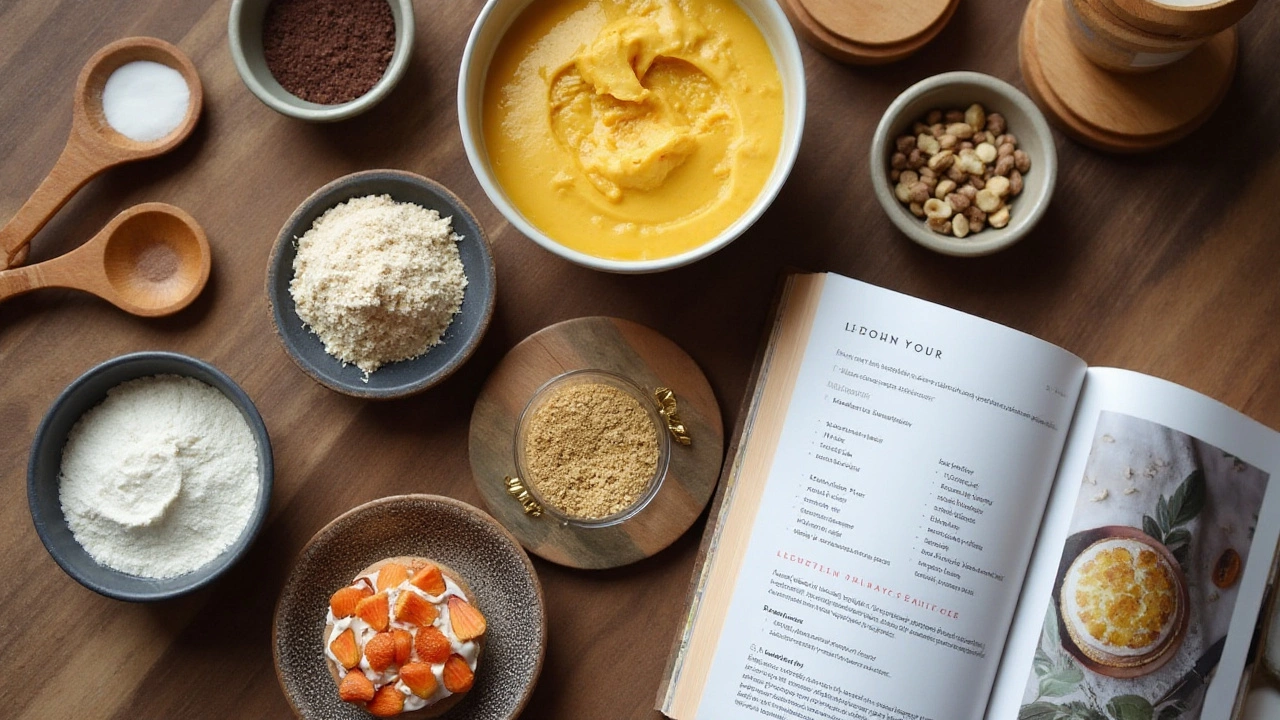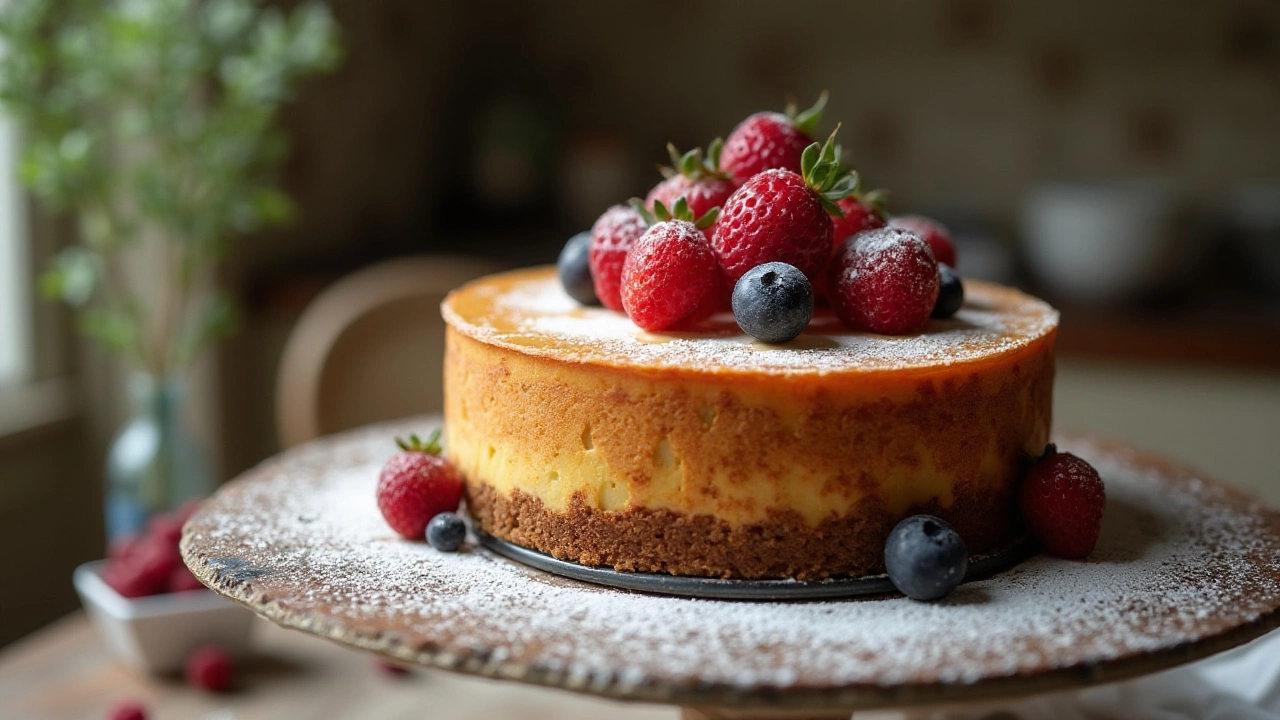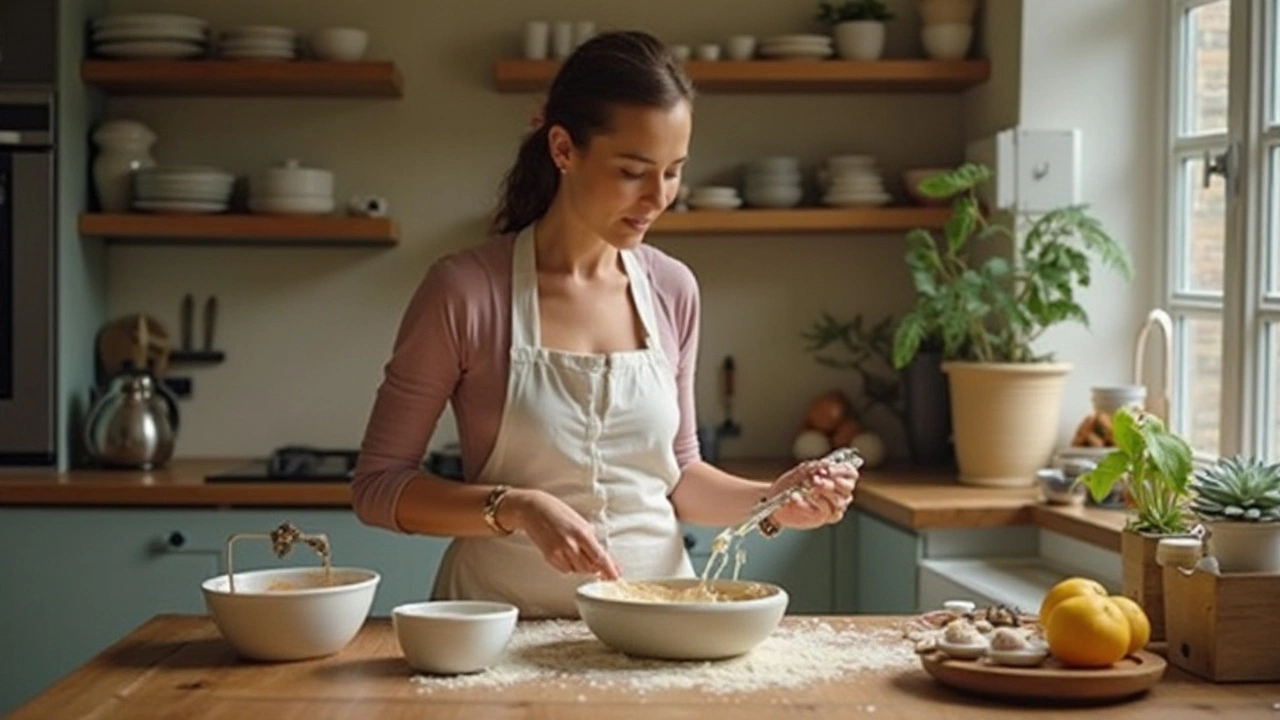
Cheesecake, with its rich and creamy texture, holds a special place in the hearts of dessert lovers. Yet, for those adhering to a gluten-free lifestyle, this indulgence often comes into question. The crust is usually the culprit, as it typically contains gluten-filled ingredients. Understanding what makes a cheesecake gluten-laden or gluten-free is crucial in enjoying this dessert safely.
For those not wanting to miss out, there are numerous ways to adjust recipes and ensure that everyone, regardless of dietary restrictions, can savor every bite. With a few tweaks and the right choices of ingredients, baking a gluten-free cheesecake that's as delicious as its traditional counterpart is entirely possible. Let's explore the ins and outs of crafting a gluten-free cheesecake and what to keep an eye out for.
- Traditional Cheesecake Ingredients
- Identifying Gluten in Cheesecake
- Gluten-Free Crust Alternatives
- Adapting Recipes for Gluten Sensitivities
- Tips for Baking a Gluten-Free Cheesecake
Traditional Cheesecake Ingredients
When delving into the world of cheesecake, it all starts with understanding its quintessential components. At its core, this dessert is composed of few but distinct elements. The base is commonly a graham cracker crust, offering a sweet and salty foundation. This crust is typically made from crushed graham crackers, sugar, and melted butter, blended until it resembles wet sand.
The main body of the cheesecake is that lush layer of a creamy mixture. This is where the magic happens. Cream cheese, the star of the show, is well-known for providing that signature smooth texture. Two or more packages of this soft cheese blend seamlessly with granulated sugar, eggs, and a dash of vanilla extract, creating that rich layer that makes cheesecake irresistible. A touch of sour cream can be added to enhance flavor and offer a little tang, balancing the richness of the cream cheese.
It’s worth noting that in certain recipes, the addition of flour or cornstarch to the filling helps in stabilizing the mixture during baking, keeping it from cracking or collapsing. This incorporation of wheat flour is where gluten finds its subtle entrance into the cheesecake narrative, primarily posing an issue for those aiming for a gluten-free status. Different cultures slightly tweak this basic recipe. Italians often use ricotta cheese instead of cream cheese for a lighter version, showing just how adaptable this dessert can be worldwide.
For those curious about the nitty-gritty, an interesting fact remains that despite its name, cheesecake is technically not a cake. It belongs to the pie family and can even tick the 'custard' box due to its composition. The historic roots trace back to ancient Greece, and over the centuries, different variations have made this dessert ubiquitous.
"A slice of homemade cheesecake is heaven. There's a science and art to its making,” says renowned pastry chef Dominique Ansel.
Traditional cheesecakes sometimes add lemon zest or a squeeze of lemon juice, which not only brightens the taste but also provides a fragrant aroma. As we peel back the layers of this culinary delight, one begins to understand the careful balance required between flavor and texture, making each slice a work of art.
Amid the evolution of its ingredients through time, the popularity and desire for cheesecake have never waned. Whether baked or chilled, with berries on top or a drizzle of chocolate, the adoration for this delicacy spans continents and generations. And as one ventures on to prepare it at home, knowing these traditional components lays the groundwork for a delicious success.
Identifying Gluten in Cheesecake
Determining whether cheesecake contains gluten requires an understanding of its basic ingredients and how they contribute to the traditional recipe's texture and flavor. Cheesecake typically consists of three core components: the crust, the cheesecake filling, and any toppings or garnishes. Typically, the culprit in terms of gluten can be found in the crust. Traditional cheesecake crusts are often made from crushed graham crackers or digestive biscuits, both of which usually contain wheat flour. Wheat flour is a primary source of gluten in many baked goods, making the original version off-limits for those on a gluten-free diet.
While the filling itself is generally gluten-free—composed mainly of cream cheese, sugar, and eggs—the potential for gluten contamination shouldn't be overlooked. It's important to read through ingredient labels carefully, even for items seemingly innocuous. Certain commercial brands might use additives or thickeners, such as specific flavorings or processed sugars, which can sometimes contain gluten. Comprehensive scrutiny is necessary when selecting cream cheese, vanilla extracts, and sweeteners to ensure zero cross-contamination. Moreover, always check for warnings on the packaging that highlight shared facilities with products containing gluten.
Addressing potential gluten in toppings is equally significant. While fresh fruits usually do not pose a gluten risk, pre-prepared toppings like fruit spreads or glazes might include gluten-based thickeners. Always verify these components individually before considering them safe for a gluten-free cheesecake. An interesting voice in this discussion is from the renowned gluten-conscious chef, Nancy Cain. She suggests, "When baking gluten-free, it's not just about swapping ingredients; it's about understanding the very essence of those ingredients—how they interact, how they transform under heat."
Nancy Cain emphasizes the importance of replacing ingredients consciously by focusing on their fundamental qualities, achieving both taste and safety.
Furthermore, exploring the makeup of gluten at a molecular level helps in recognizing how seemingly minor ingredients may contribute to gluten presence. Gluten is a combination of proteins found in wheat and its relatives, giving dough elasticity and chewiness—a desirable trait in traditional crusts but one that must be deliberately removed when adapting recipes for gluten-free consumption. Therefore, understanding how these proteins react and interact provides the foundation for effectively identifying and eliminating gluten from classic cheesecake recipes.

Gluten-Free Crust Alternatives
When aiming to transform a traditional cheesecake into a gluten-free delight, the crust is typically the piece of the puzzle that requires the most attention. Classic crusts often involve crushed graham crackers or cookies that contain wheat. However, there are numerous gluten-free alternatives that promise to deliver the same satisfying crunch and flavor without the gluten. One popular choice is using gluten-free graham crackers or cookies, which are now widely available in grocery stores. These can be crushed and mixed with melted butter to form a perfect base for your cheesecake. As a bonus, they often come in a variety of flavors like vanilla and chocolate, which can add a unique twist to your dessert.
Another fantastic option is using nut-based crusts, which not only cater to a gluten-free lifestyle but also introduce a depth of flavor and texture. Almonds, pecans, or walnuts can be finely ground and mixed with a small amount of sugar and butter to assemble a crust that is both rich and complementary to the creamy nature of cheesecake. Nut crusts are also appreciated for their simplicity and the fact that they can easily be adjusted to meet individual taste preferences, making them an inventive and versatile option for bakers.
For those preferring something unconventional, consider experimenting with gluten-free rolled oats or quinoa flakes. These grains can be combined with honey or maple syrup and coconut oil to create a hearty and fiber-rich crust. This approach not only aligns with a gluten-free diet but also offers a wholesome twist, especially suitable for those conscious about their health. These ingredients promise a robustness and a unique texture, setting your dessert apart as both nutritious and delicious. Moreover, they can be prepared in advance and stored, offering convenience for busy bakers.
An exciting trend in gluten-free baking is the use of coconut or almond flour, both of which provide distinct flavors and textures. Combining these flours with a touch of butter and a bit of sweetener like coconut sugar can result in a crust that is not only gluten-free but also tantalizingly fragrant. Such ingredients can enhance your dessert, providing a tropical or nutty aroma. The use of alternative flours is a testament to how diverse and creative gluten-free baking can be. This opens up endless possibilities for customization, aligning with personal tastes and dietary needs.
Finally, it's worth considering crustless cheesecake options. While the base layer often provides a textural contrast to the creamy filling, eliminating the crust altogether results in a dessert that highlights the pure flavor of the cheesecake. This method is perfectly suitable for those with gluten intolerance or for anyone seeking a light and velvety version of this beloved treat. Crustless cheesecakes can still be dressed up with fruit toppings, caramel drizzles, or a sprinkle of nuts to add the desired finish.
Cheesecake expert Alice Medrich once said, "The beauty of cheesecake lies not just in its creamy decadence but also in its adaptability." This sentiment captures the essence of creating a gluten-free cheesecake that accommodates personal tastes while maintaining that signature indulgence.
Adapting Recipes for Gluten Sensitivities
Turning a traditional cheesecake into a gluten-free delight isn't as daunting as it might seem at first glance. The primary concern usually lies in the crust, which is commonly made with graham crackers containing gluten. Fortunately, the marketplace is now teeming with gluten-free options. Many stores offer gluten-free graham crackers and biscuits, making substitutions quick and easy. Alternatively, one can use almond flour or ground nuts as the base for a delicious, naturally gluten-free crust.
Ingredients are just part of the puzzle; techniques matter too. When using gluten-free products, one might notice variations in texture. For instance, gluten-free flours might not bind as easily as their wheat-based counterparts. This can be addressed by adding a teaspoon or two of xanthan gum, which helps replicate the elasticity gluten would typically provide. Care in mixing is also key, as overmixing can lead to a dense and less desirable texture, even in a gluten-free version.
It's also wise to keep kitchen practices in mind to avoid cross-contamination. Designate specific utensils and equipment solely for gluten-free baking. Even the tiniest crumb of gluten can compromise the dessert's status for those highly sensitive or with celiac disease. Many professional bakers emphasize this point. Renowned baker Alice Medrich once noted,
"The key to successful gluten-free baking lies not just in substitution but in awareness of cross-contamination and careful handling of ingredients."
Experimenting with Flavors
Making a gluten-free cheesecake doesn't mean limiting creativity. In fact, adapting recipes often opens new doors for flavor experimentation. Adding unique ingredients can enhance the texture and flavor profile of the cheesecake. Try incorporating spices like cinnamon or nutmeg in the crust, or flavoring the creamy filling with vanilla bean, lemon zest, or even a hint of espresso. Such modifications not only elevate the taste but can make your dessert stand out at any gathering, earning praise from even the pickiest guest.
If pairing different textures and flavors intrigues you, consider layering. For example, spreading a thin layer of homemade fruit compote between the crust and the filling introduces another dimension to the classic cheesecake experience. This not only diversifies the palate but also gives a lovely visual appeal. Combining fresh seasonal fruits can also be a game-changer, offering bursts of taste and color with every bite. Embrace the art of making gluten-free adaptations and enjoy the journey of crafting delectable desserts without gluten.

Tips for Baking a Gluten-Free Cheesecake
Baking a gluten-free cheesecake is a delightful culinary adventure that requires a bit of creativity and know-how. First and foremost, selecting the right ingredients plays a vital role in ensuring your cheesecake is not only gluten-free but also delicious. The primary ingredient to replace is the traditional graham cracker crust, which contains gluten. To create a gluten-free version, you'll want to explore crust alternatives such as crushed almonds, pecans, or even gluten-free cookies. Each alternative brings a unique flavor and texture, allowing you to customize the cheesecake to your liking. It's important to crush them finely, mix with just a touch of melted butter or coconut oil, and press them firmly into the base of your springform pan.
Precision in mixing your cheesecake batter is essential, too. Preventing lumps starts with allowing the cream cheese to reach room temperature before mixing; this ensures a smooth and creamy texture. Incorporate other ingredients like sugar, eggs, and vanilla extract gently, using a low-speed setting on your mixer to avoid air bubbles that might cause cracks in the top of your cake. It can be beneficial to add a tablespoon of cornstarch or gluten-free flour to stabilize the batter. In an article from 'The Gluten-Free Baking Club', they suggest, "Adding a bit of lemon juice can enhance the flavor profile without overwhelming the creaminess."
The baking process itself requires attention as well. Many experienced bakers recommend using a water bath to maintain moisture in the oven, which helps in achieving that perfect silky texture without cracks. Simply wrap the outside of the springform pan with aluminum foil to prevent water from seeping in, and place it in a larger pan filled with about an inch of hot water. Patience is crucial; avoid sudden temperature changes by turning the oven off and letting the cake cool gradually inside. This minimizes sinking and cracking issues. Once cooled, a rest period in the refrigerator, ideally overnight, will help set the cheesecake and intensify flavors, rewarding your patience with a dessert that's ready to shine.
For those who aim to experiment further, there's a range of toppings that can elevate your gluten-free cheesecake. Fresh fruits, fruit compote, or a drizzle of chocolate sauce can not only enhance appearance but add contrasting flavors and textures that create an unforgettable dessert experience. Remember that simplicity is often key, allowing the pure flavors of the cheesecake to remain the highlight. Using seasonal fruits not only adds a touch of color but ensures you're getting the freshest and most flavorful toppings that complement the cheesecake's richness beautifully.
In the end, making a gluten-free cheesecake is an art that invites trial, error, and joy in its creation. With every attempt, you'll discover new techniques and flavors that will help you perfect your dessert. Sharing your masterpiece with friends and family becomes not just a treat for the taste buds but a testament to your baking prowess. Whether you're catering to dietary restrictions or simply exploring new recipes, there's something uniquely fulfilling about crafting a delicious and gluten-free dessert from scratch.
- tags : cheesecake gluten-free dessert baking